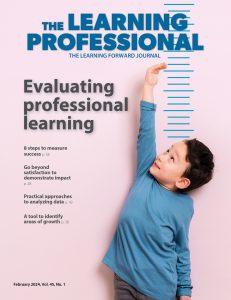On the first Monday after Election Day and more than two months late, the Senate Appropriations Committee finally introduced its versions of all twelve FY21 Appropriations bills, including Labor HHS Education Appropriations. Overall, the Senate education spending bill provides somewhat less money for the Department of Education and its programs than does the House version, which passed the House months ago. For Title II, a program that is of great concern to Learning Forward because it represents the central source of federal K-12 professional learning money, the Senate bill provides no increase over last year while its House counterpart contains a $23 million increase. Other important, larger K-12 programs also receive fewer dollars in the Senate funding bill than in the House’s version.
Overall, the Senate education spending bill increases Department of Education spending by $490 million over last year, with the vast majority of key education programs receiving either level funding or slight increases. The House version, by contrast, increases Department of Education spending by $716 million over last year and provides more and bigger programmatic increases than does the Senate bill. In the Senate version, Title I and IDEA each receive an increase of $125 million, far less than they receive in the House bill, which provides for $254 million more for Title I and $208 million more for IDEA. The funding level differences between these two bills will no doubt be at the heart of education funding negotiations. Another flashpoint is likely to be funding for charter schools. House Labor HHS Education Appropriations Chair Rosa DeLauro (D-CT) has been highly critical of charter schools and, in the House bill that her subcommittee produced, the Charter Schools program receives $40 million less than last year. The Senate bill not only adds back that money but increases funding for the program by $10 million. It will be interesting to see who wins the battle of wills on this line item. Other key areas to watch in negotiations: the Education, Innovation and Research program, which sees a small increase in the House bill but sustains a $60 million cut in the Senate bill; the Title IV flexible block grant program, which receives a $10 million increase in the House bill but a $40 million increase in the Senate’s; and the Perkins Career and Technical Education program which receives a fair increase in the House ($18 million) but a very good increase in the Senate ($75 million).
Now that both the House and the Senate have put their cards on the table, the two chambers will begin to negotiate on final, conferenced versions of all of the appropriations bills, aiming to finish before December 11, when the temporary budget measure that is keeping the government operating expires. Learning Forward plans to work with its allies to press the negotiators to accept the House’s proposed increase for Title II. There remains a decent chance that will happen. Senate Appropriations Ranking Member Pat Leahy (D-VT) has called for more education spending in a final bill and we know that House Labor HHS Education Appropriations Chair Rosa DeLauro (D-CT) is a strong supporter of educators and Title II.








